Pharmacists are going to be allowed to prescribe Paxlovid, while doctors continue to be confused by the guideline of ‘you can give this life-saving medicine that cures disease to the people who are sick with that disease.’ The news on the vaccine update front is good. Cases and deaths went unexpectedly higher, which is slightly worrisome, but seems unlikely to indicate anything big.
On an unrelated note, I’ve also written a bit about a giving-people-money experiment in Chicago that did not go so well. With Covid quieting down, I’m likely going to be lowering the threshold for including non-Covid items in the weekly updates. The alternative was to have a growing backlog of things that I am unlikely to ever get to deal with.
Executive Summary
- Get Paxlovid at your pharmacist, yay.
- Vaccine update update is they are closer to updating.
- Monkeypox continues to double every 10.5 days or so.
Let’s run the numbers.
The Numbers
Predictions
Prediction from last week (4th of July): 600k cases (-13%) and 1,800 deaths (-16%).
Results: 675k cases (-1%) and 2,272 deaths (+11%!).
Prediction for next week: 700k cases (+5%) and 2,250 deaths (-1%).
Cases and deaths both going unexpectedly higher implies there wasn’t much of a holiday effect. Deaths in particular have no reason to be higher even without a holiday effect, so that’s weird but I did adjust for Florida and the effect is still there in the South. My guess is some of this is random rather than permanent, but it’s hard to say, and I still have to presume that there was some amount of holiday effect to undo.
Deaths

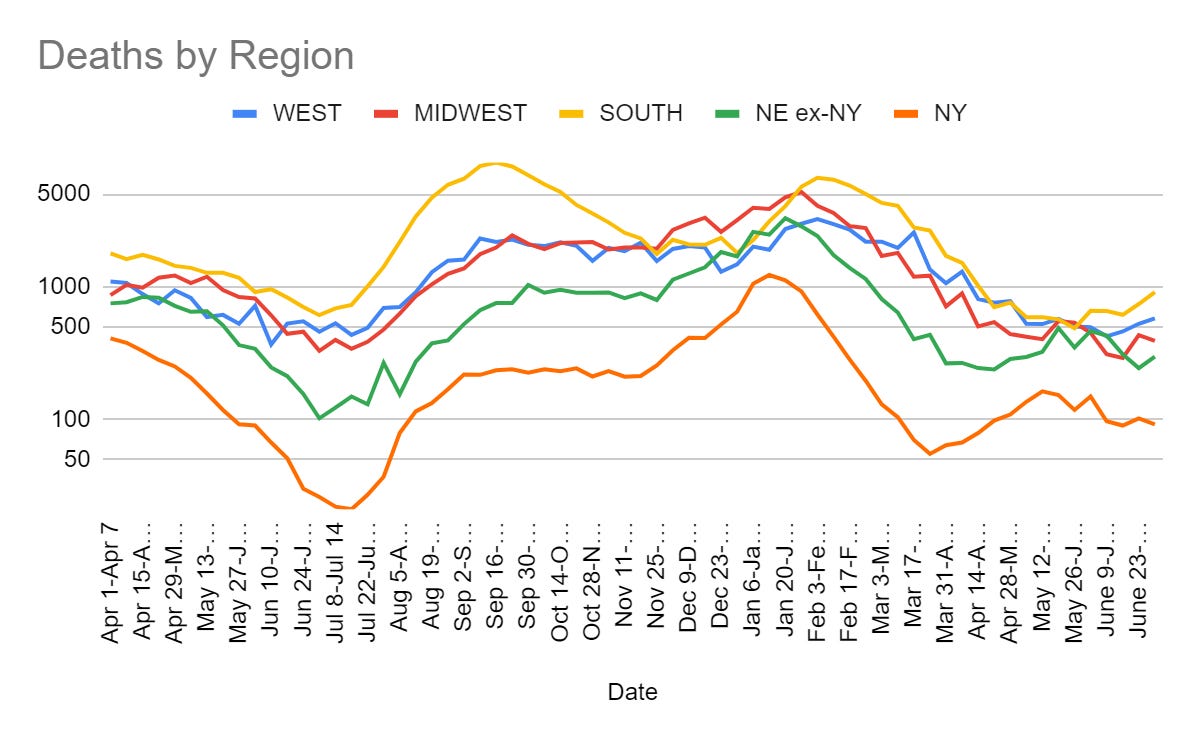
Cases

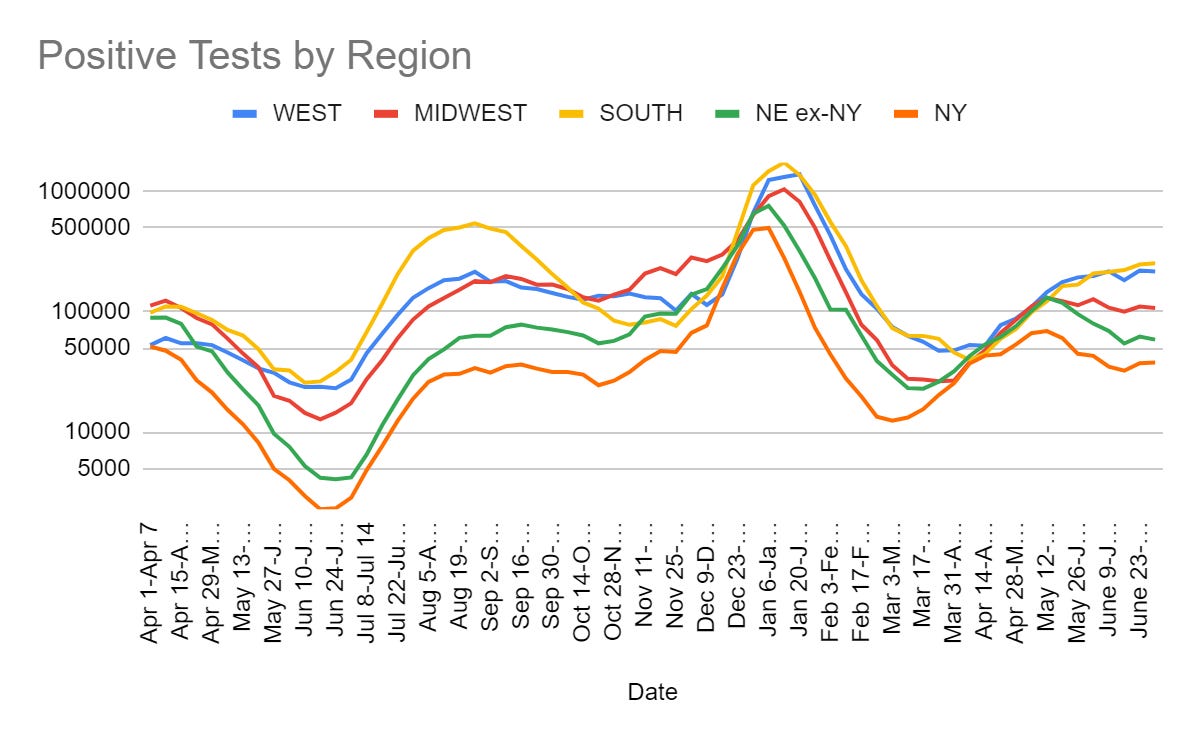
Did you know this in many places represents medium or high levels of Covid?
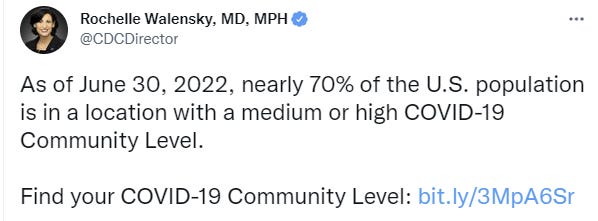
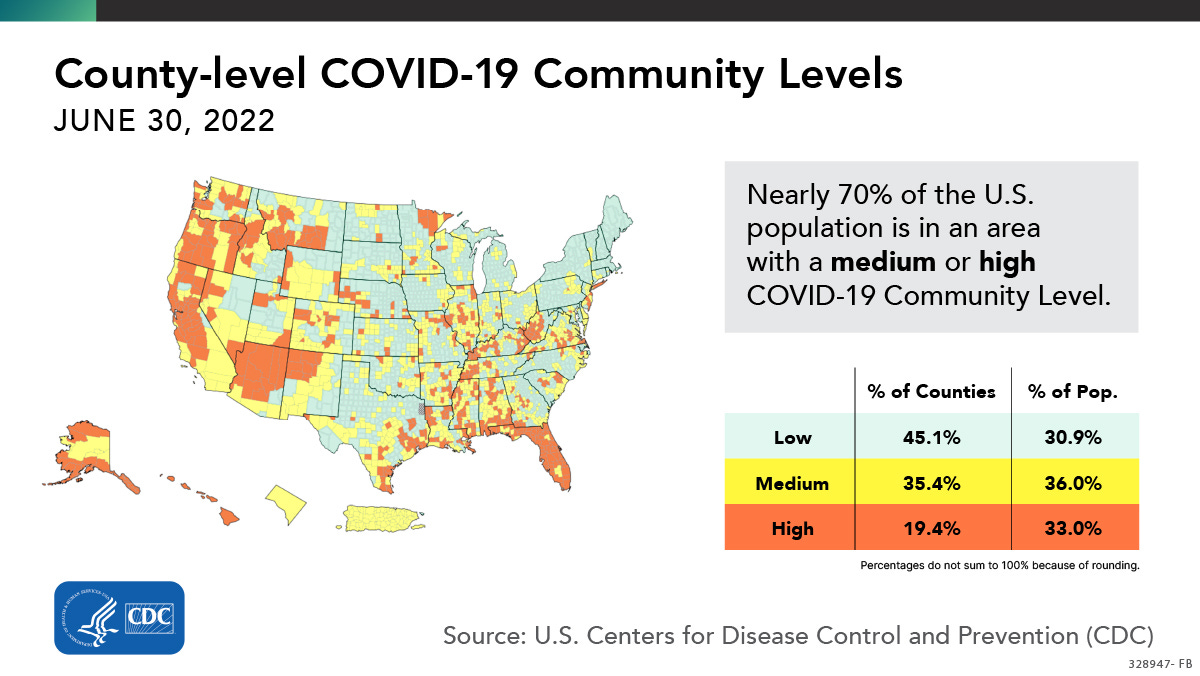
All right then.
Paxlovid at the Pharmacist
You will be able to get Paxlovid prescribed to you directly by the pharmacist. Seems like an excellent development. I’m actually starting to notice a pattern of such pockets of sanity happening more often recently, after delaying long enough to let a lot of the value be destroyed, in quiet places where no one is looking. It’s as if they are worried someone will notice someone is optimizing for good outcomes in this hive of scum and villainy, and so they must be cautious.
You can also get Paxlovid at the Pop-Up here in NYC.

Meanwhile, doctors clamor for more clarity. Yes, we are allowed to prescribe life-saving medicine to (more or less) all our patients with Covid-19, but who should be taking Covid-19 sufficiently seriously that we should give them life-saving medicine for it? Should a healthy 50-year-old get life saving medicine, or are they at such little risk they shouldn’t bother, despite us locking them down for the better part of two years over this?
I mean, who needs a cure, anyway? So many confusing questions.
Vaccine Update Update
Matthew Yglesias reminds us that vaccines work better when you update them, and that we need to update our vaccines faster, and that other considerations don’t much matter.
Back in February of 2021, the FDA suggested that in the future, variant-optimized vaccine updates would be fast-tracked for approval.
They suggested at the time that companies “would need to submit new data that shows the modified vaccine produces a similar immune response and is safe, similar to the process for annual flu vaccines,” and this could be done “without the need for lengthy clinical trials.”
That would have been a good idea! But instead they seem to have opted for months of intensive clinical trials. The problem there, which should be obvious, is that while the clinical trials enhance our confidence that the new booster is in fact more effective against Omicron, they also radically decrease the real-world efficacy of the Omicron-optimized booster by ensuring that it gets into people’s arms far too late. As the original coverage stated, the FDA understands this tradeoff perfectly well in the case of the flu vaccine. Incidentally, it is genuinely true that because flu vaccines are sort of rushed out the door, their efficacy varies a great deal from year to year. In theory it would be better to test more carefully. But time is of the essence so the best thing to do, all things considered, is approve vaccines quickly and let people get their annual shots.
Doing the same for Covid seems like a no-brainer, but for some reason they didn’t do it.
The good news, however, is that they very recently announced that future optimized boosters will be able to skip the clinical trials.
Next time will be different, this last link says. Won’t make same mistake a third time.
NEW YORK (Reuters) – The U.S. Food and Drug Administration will not require companies to submit clinical trial data on COVID-19 vaccines modified to protect against the BA.4 and BA.5 versions of Omicron in order to authorize those shots, a top FDA official said on Thursday.
Dr. Peter Marks, head of the agency’s Center for Biologics Evaluation and Research, told Reuters the agency will rely on data from clinical trials vaccine makers have run on shots designed to combat the BA.1 lineage, as well as manufacturing data, for emergency use authorization submissions before the fall.
…
Marks said he believes regulators from other countries are seriously considering using BA.1-based vaccines, which some drugmakers have already been producing and may be available sooner.
I can’t help but notice that ‘we can update quickly without a trial’ is what they said when they first made the vaccines. So I am skeptical that we’ll return to that policy.
It does not give solace to know that other countries are going to act even stupider, and choose to update to a version that is all but known to be less effective over a version that is more effective. Instead, we simply used a less effective vaccine for seven months, and this one time we are going to let it not get put back into another clinical trial afterwards and get caught in a never-ending loop of always being behind. This one time, we will have something up-to-date for one shining moment.
Yet I see nothing here to indicate this is a general policy change to ‘give people the version of life-saving medicine most likely to net save their life even if we haven’t specifically tested that particular version for so long it is no longer the right version’ and every reason to think that because BA.4/BA.5 are a sub-variant off of BA.1 and the whole thing is super embarrassing they are going to do a one-off waiver.
If the Pi variant breaks immunity again, do you expect them to waive the clinical trial requirement for a vaccine update? I don’t. Certainly I do not expect this if that Pi variant is about as dangerous as Omicron. If it was suddenly far deadlier as well, I hold out hope that this would matter, but it would be a modest amount of hope at best.
Don’t Just Do It, Do More
This is a very long thread about the art calling for the doing of more.
In particular, it is about noticing that if you go around screaming about how dangerous Covid is, there will exist a group of people who think that it will definitely, deterministically kill you.
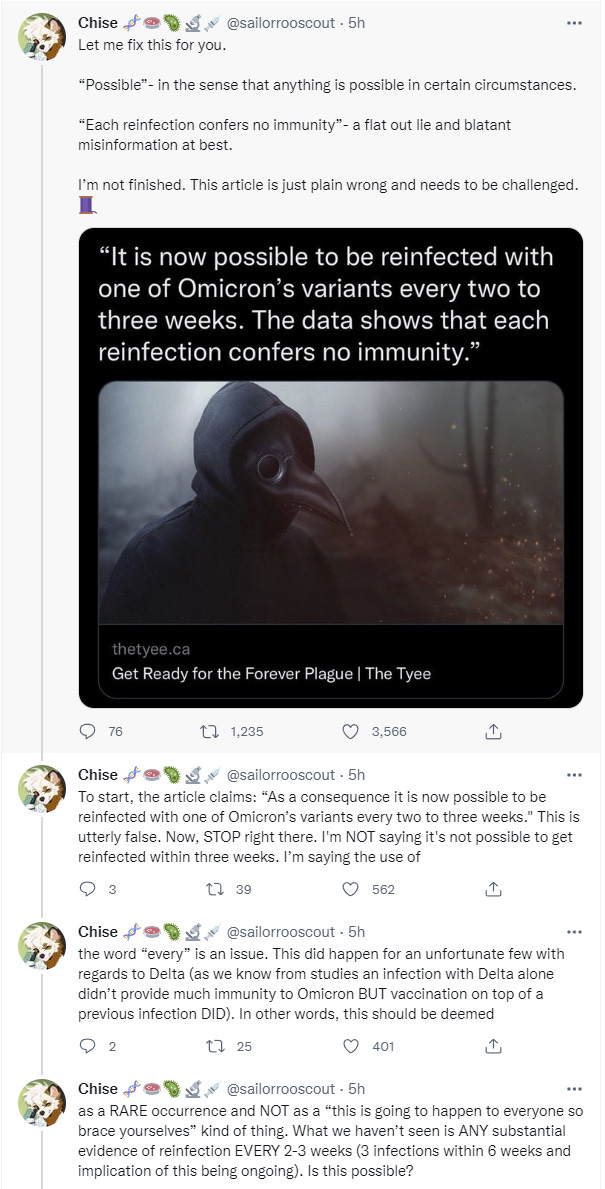
That thread continues for a long time, in case you need any more pushback on the article in question. You get the idea.
People are not great with subtlety or nuance. And scaring them in this way might not be good for either mental sanity or public trust.
As usual, people are talking literally, others are trying to pretend that first group could not possibly have been talking literally, but, yeah.
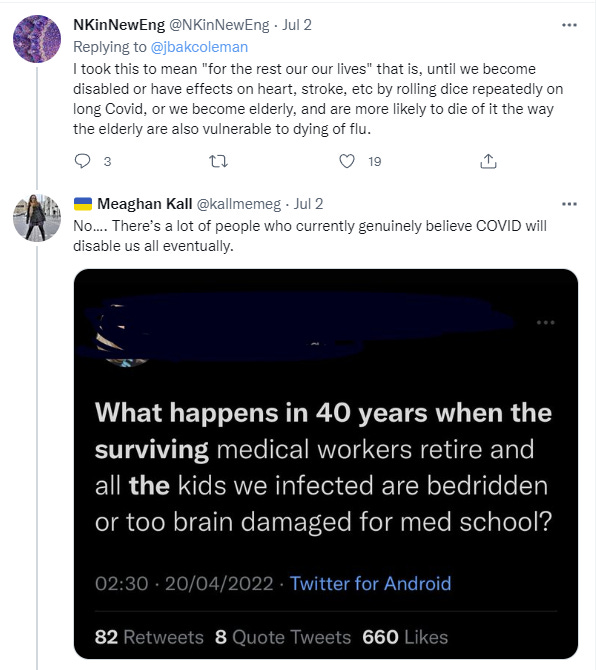
No, really.

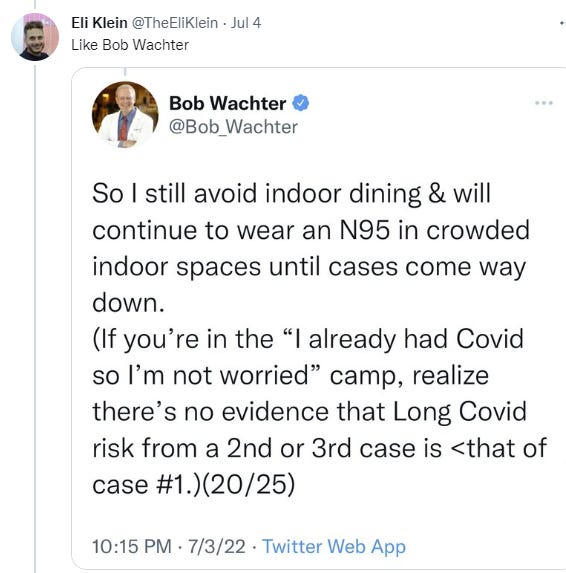

There is one study helping spread such misinterpretation this week but there’s always a study this week. There will be one next week, too.
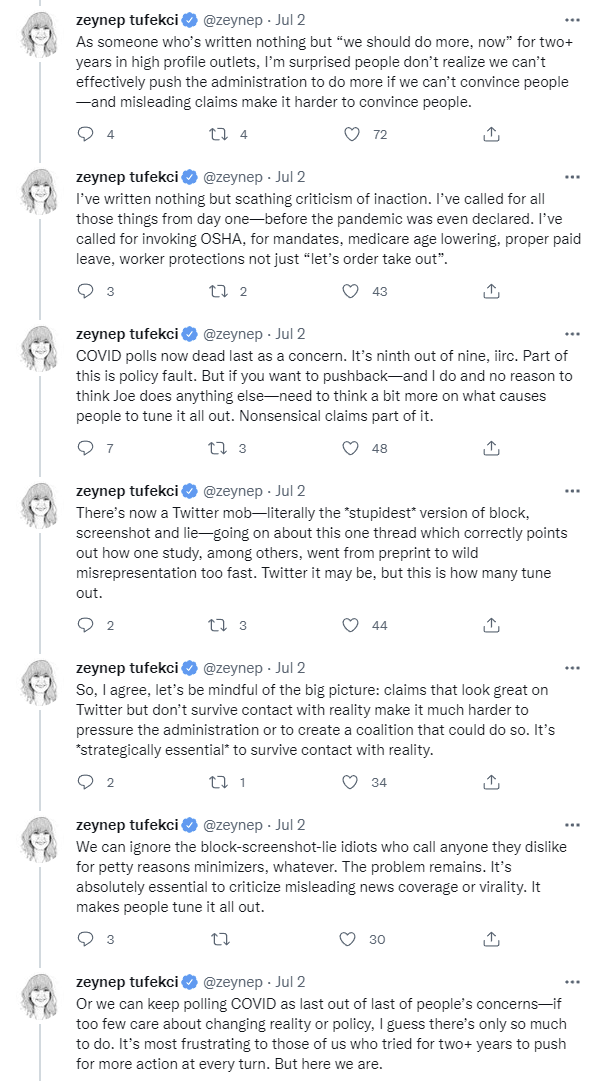
There are reasonable ways in which it would be a very good idea to do more, in particular involving the vaccines. The problem is that no one cares. The only people who do still care are mostly some combination of public health or Cult of Superficial Safety people who think we should Do More all the time about everything, and those who have bought into the idea that Covid is far, far more dangerous than it is, especially reinfections and Long Covid.
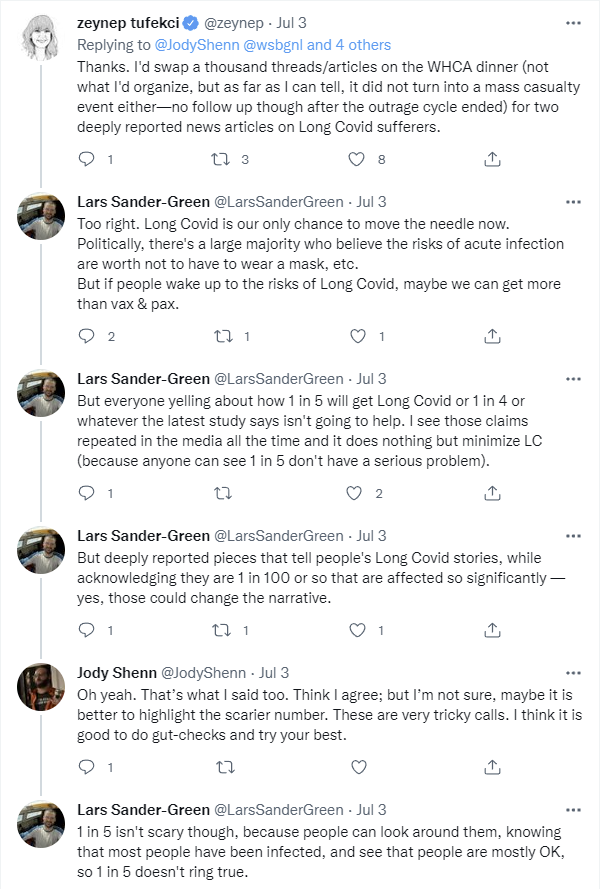
That’s the thing. There will, over and over, be claims that say 1 in 5 people will get Long Covid with no evidence that reinfection is safer, or what not. And then any normal person will go ‘wait, that does not make any sense, I know lots of people who got Covid, often multiple times, that we even know about, and all but one of them are fine’ and then they start quite rightfully ignoring you.
This is better than many alternatives. I do not want the Doing of More to occur on most fronts. The Doing of Nothing is, as I’ve said many times now, feeling like it is mostly a case of ‘your terms are acceptable’ given the practical alternatives. I don’t like not funding vaccines, but you cannot win them all.
Free State of Florida Man
The Florida Man will continue, until further notice, to be Ron DeSantis. He has a thing to say about anyone who has a thing to say about him.

This is a pattern. If you speak out against DeSantis, and he has any levers of power to go after you, he will use them. Doesn’t matter if you’re a professor at a Florida university or the almighty Disney corporation, words can never hurt him but he’s going to take the gloves off to be sure.
That does not, of course, discourage those for whom DeSantis lacks such levers, which is most people, especially those outside Florida and even more especially most of Twitter.
Such folks tend to focus on the DeSantis’s failure to Sacrifice to the Gods. You see, people are dead. Or, mostly nowadays, people are testing positive.
If you’re not inflicting pain on your citizens to make it go away, that all becomes your fault. That’s simple logic. Hence things like this:
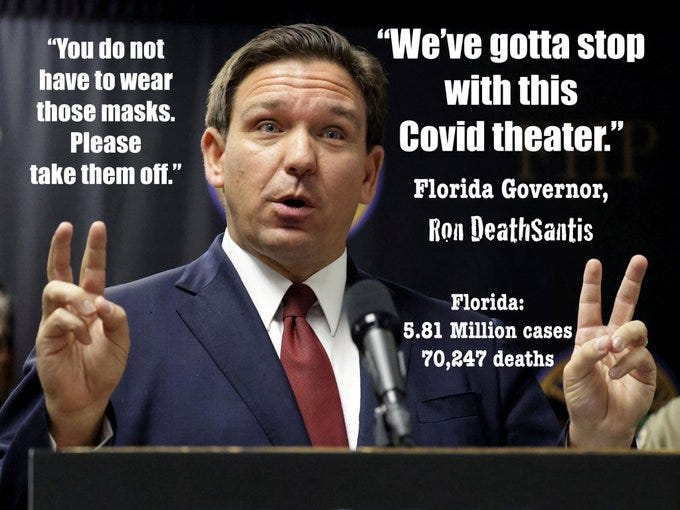
Except yes, we do need to stop with this Covid theater, and citing that Florida had mostly average numbers of deaths and cases is not going to make people dislike what he did with the place. DeSantis’s Covid response is popular, and especially popular among Republicans. Every time people post something like this, thinking they’re giving it to him real good, the chance DeSantis becomes president goes up a little bit.
If you do not understand this, you are confused about both Florida and man.
FDA Delenda Est and its Busy Schedule
Did you know that what is freedom and your sacred right is determined by the FDA?

If it is approved by the FDA, well then, we must protect your rights of access at all costs. If it’s not approved by the FDA, it’s illegal, period. Nothing else should determine when it is our body, our choice versus when it is… not that.
Biden will now get back to telling people to stop charging market clearing prices for gasoline or he’s going to stay angry and you don’t like him when he’s angry.
A fun little story about how the FDA took time out of its busy schedule and went after Lazy Cakes melatonin-infused brownies to forced them to change their label, because…
“The inclusion of melatonin in baked goods raises numerous health concerns,” Sen. Dick Durbin (D–Ill.) wrote to the Food and Drug Administration (FDA) in May 2011, asking the federal agency to launch an investigation because the “sweet, chocolaty taste may encourage consumers to eat well over a recommended quantity of melatonin.”
There are so many FDA and Cult of Superficial Safety (their motto: “Why? Just ‘Coss!”) tropes there. The fear that someone might take more than the ‘recommended’ amount of something (while, of course, anyone consuming brownies is likely consuming a lot more calories and sugar than the ‘recommended’ amounts, in ways far more damaging than melatonin, and yet in a huge surprise I intended to do this every so often anyway.) The idea that if you combine perfectly normal, legal, safe and sensible thing A with other similar thing B, in a way that makes customers happy, it is suddenly a blameworthy thing to do because you see customers might prefer A+B to B, and that would be bad.
And of course, it’s important to remember that the FDA’s reach exceeds its grasp, and how just awful it is that something might be dangerous to “young children.”
As the FDA had its eye on the cakes, state and local officials in several jurisdictions went ahead and banned melatonin-infused products. A statewide ban of melatonin brownies, the Arkansas Department of Health declared, was necessary because the products could be especially dangerous to “young children”—even though “potential side effects associated with taking this hormone have not been fully determined.”
Sounds scary like that. Potential side effects have not been fully determined, oh no, there might be any potential serious side effects at all, at some dose with some duration in some population, that we find at some point. So we had better be careful. Please do not notice that this is a fully general argument for banning actual everything a human might do or consume.
The FDA has also continued to ensure we are safe from effective sunscreen. This particular example is so egregious that a law was passed, and the FDA simply ignored it.
…In 2014, Congress passed a law attempting to speed access to sunscreen ingredients that have been in wide use in other countries for years, but it hasn’t really worked. “The FDA was supposed to be fast-tracking these ingredients for approval, because we have the safety data and safe history of usage from the European Union,” Dobos said. “But it seems to continually be stalled.” According to Courtney Rhodes, a spokesperson for the FDA, manufacturers have submitted eight new active ingredients for consideration. The agency has asked them to provide additional data in support of those applications, but none of them has yet satisfied the agency’s requirements.
All your sunscreen are belong to us.
The good news is they have temporarily suspended their demand that Juul cease all sales, which if implemented is likely to kill quite a few people.
Control, Control, You Must Learn Control
Advocates warn America at risk of losing control of Monkeypox.
The details represent our utter failure to respond in reasonable fashion to Monkeypox, in all the same ways we failed to respond reasonably to Covid-19. This does not bode well for the next actually scary pandemic.
The good news is that we are not at any risk of losing control of Monkeypox.
The bad news is that this is because we were never at any risk of being in control in the first place.
What does the word ‘control’ mean here? There was never any willingness to take the kinds of actions necessary to stop the spread of monkeypox within the subcultures where monkeypox has been spreading. Thus, there was only one way this could go for those subcultures. Which is exactly how it is going, in case anyone wanted to see the definition of exponential growth.

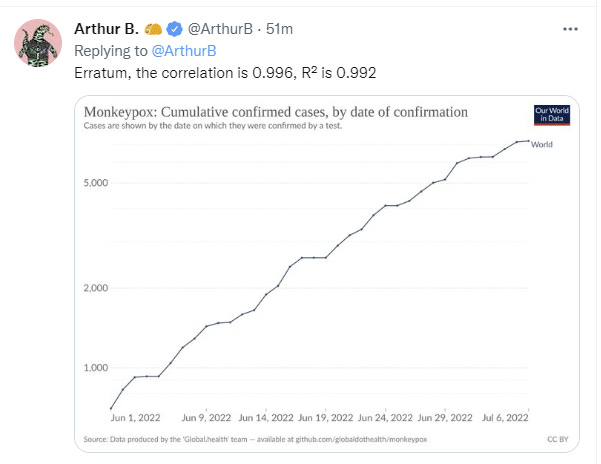
There was never any hope of control, in that sense.
And in the sense that this indicates that authorities are doing exactly nothing that impacts the spread of monkeypox.
The question is whether monkeypox spreads sufficiently that it is a threat to spread beyond those subcultures, and be something everyone has to worry about. I continue to believe the answer to that question is mostly no, beyond an awareness that if you see signs of pox you should get the hell out of there.
The Death Cult
The Dutch signed an agreement to cut down on Nitrogen use, which they will do by shutting down farms in the middle of a potential worldwide famine. The farmers are understandably not thrilled and are protesting, using various methods.
The policy in question will require Dutch businesses to reduce nitrogen emissions nationwide by 50% and up to 95% in some provinces by 2030, with cows and fertilizers being significant contributors.
“The honest message … is that not all farmers can continue their business,” a government statement reads.
The agriculture industry isn’t the only one being targeted, though — aviation has also come under fire.
According to Climate Change News, by the end of 2023, Schiphol airport, one of the busiest in Europe, will be forced to limit annual flights to accommodate just 440,000 passengers (12% less than the number of flights in 2019).
…
Climate change activists are, of course, thrilled by the developments, with Greenpeace calling the cap on airport traffic a “historic breakthrough.”
“It is good that the Cabinet realizes that Schiphol has, for years, been flying beyond all boundaries when it comes to noise, nitrogen, ultrafine particles and the climate,” Greenpeace activist Dewi Zloch said in a statement.
The good news is with all the extra requirements for pilots we probably couldn’t have kept all those flights in the air regardless. At least now the planes might be on time.
Now they’re blocking the airport, which seems like it only encourages the bastards?
Shutting down farms during a famine definitely feels like it falls under ‘things that would have gone into certain novelizations of government intervention causing civilizational collapse except it would have made the whole thing feel too far fetched.’
There are those who think that not having an industrial civilization would be a good thing. That producing less food would mean more people, which would also be a good thing. Those people seem to have a large say in European policy decisions. I do not expect this to end well.
In Other News
New Fargo study finds no effect of school mask mandates on infection rates.
It seems they’re still denying hospital visitation rights to the unvaccinated?
Mexico’s wise president moves to end daylight savings time.
Delta cuts college requirement for pilots given they still need an absurd 1,500 hours of flying, usual suspects assume that any reduction in any requirement must somehow endanger safety of the safest form of travel in the history of mankind. Does not occur to them that the 1,500 hours might have something to do with the shortage.
BBC may not know the words but it definitely knows the music.
Schools at least do something, in the sense that kids who were kept out of school for extended periods and instead forced to do highly terrible ‘remote learning’ instead did quite poorly, in proportion to how long the schools stayed closed. Or at least they avoid the harm from remote learning.
Evergreen Tweet in the style of Hillary Clinton, perfect, no notes.

How we should think about most Covid precautions, in one Twitter thread.
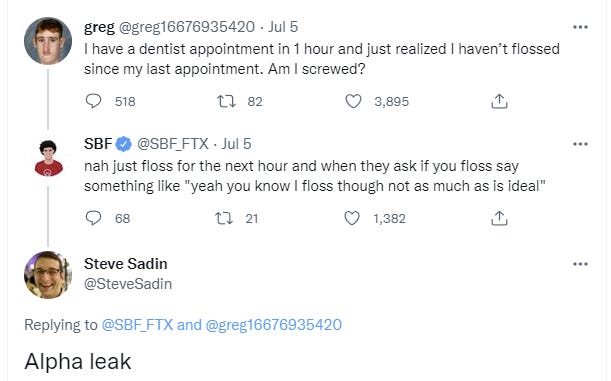
Biden administration looking to open up our formula market to imports and a diversity of suppliers. Great idea, but why did we want until after we dealt with our shortage of formula? Perhaps something about trying to optimize for good outcomes in a hive of scum and villainy.
Meanwhile in California, AB-5 is set to force the trucking industry to make radical changes that at best will dramatically increase shipping costs. At worst, it will greatly disrupt the ability to ship things, many things won’t get shipped, and it gets rather ugly. The thing is that this is exactly the kind of thing that renders such systems inflexible. It both limits supply and also limits ability to increase supply. There’s a substantial chance this gets pretty ugly.
Movie stars are getting older. If this wasn’t part of a general pattern one might say it was good news, people valuing quality and experience rather than churning hot 19-year-olds. In the context of other things getting older, not as encouraging.
They are also suffering from hyperinflation. Please give generously.
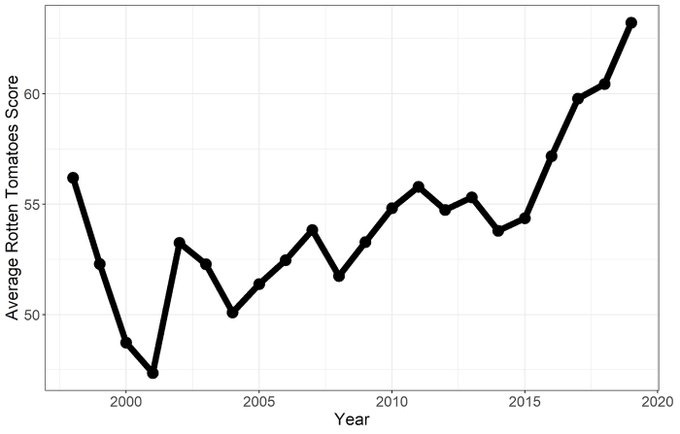
In case you didn’t have a high probability of doom given AGI, let’s help nudge you a bit. DeepMind is already explicitly optimizing for what will be approved of rather than what would turn out well.

I think you’re being a little hard on the docs who are asking for clarification about when to prescribe Paxlovid. Obviously it’s a waste of $500 worth of medicine to give it to a healthy kid. Now, where do we draw that line? At what point is prescribing it worth the $500 that the insurer or the government or whatever is paying?
More importantly, it has several bad interactions with commonly prescribed medications. If a patient is on statins (very common), they’ll need to go off them for the duration of their Paxlovid course. That might not be great for the patient. When is it worth it to prescribe the stuff anyway?
> Obviously it’s a waste of $500 worth of medicine to give it to a healthy kid.
It’s also a waste of $500 worth of medicine to let it expire, though. If substantial numbers of doses of Paxlovid are expiring and being thrown away (I’m not sure they are), then their “effective” cost is zero (modulo what you say in the second paragraph).
It’s a course of pills, so the shelf life must be at least a year.
It really is not. Pharmacies will usually order as little as possible, so their waste is minimized. Whereas manufacturing is relatively cheap, maybe a few dollars, not even close to $500. We should think of these drug prices more like software or intellectual property. A big initial investment for developing or writing and then every copy is just to a few dollars to make or distribute. Most of the price is for licence, not for the physical copy.
Slow manufacturing: Paxlovid is surprisingly difficult to make. The nirmatrelvir component specifically has a long pipeline of difficult, slow reactions that means it takes months to make a new batch. (The ritonavir component is less problematic, since it’s an already-approved drug used in several HIV therapies.)
Shelf life: The official shelf life of paxlovid is now 12 months, up from the previously estimated 9 months. That’s an FDA estimate, so it’s likely quite conservative and the effective shelf life is likely to be longer. This assumes, of course, “proper storage conditions” (not too onerous for paxlovid, say, in comparison to the mRNA vaccines which require -70C storage).
So it’s slow to make the stuff, but you can keep it for a year with reasonable care.
Hi Weekend editor,
Yep, the extremely convoluted supply chain is to make it as cheap as possible. Get some cheaper ingredients from China and India, send to Mexico to pre-processing due to cheaper workforce, then when you have a final product, send to Ireland to package it for possible tax rebates etc. etc.
The UK some pharmacists used to prescribe Paxlovid but no longer because covid is mostly over. Remaining cases can be dealt by hospitals or GPs. No need to spend $500 on people who are not high risk and for whom benefit/risk ratio is not established (and not likely to be very high).
I’m not saying there isn’t a line somewhere – obviously I wouldn’t give it to a 9 year old. But also I think that if you’re smart enough to get through medical school and residency then you should be able to make reasonable decisions rather than thinking that only guidelines can make decisions? I’m fine with a doctor whose threshold is different from where I’d put it up to a point.
I agree with you there, they are being babies by trying to abdicate responsibility.
What are the most likely reasons behind the spike in the number of deaths? How much should I be personally concerned about the elevated risks (M31, double-vaccinated, probably never infected, generally healthy and of normal weight, though stressed out, isolated, and sedentary)?
This video seems worth the time: https://www.youtube.com/watch?v=7f45S6vmQgA
I mean that’s not really a spike, it came in higher for the week than expected. It certainly doesn’t mean you should suddenly be worried.
(As for video, I hate the medium, so going to need a stronger justification than that.)
Is there any point in looking at case data anymore instead of just relying on wastewater analysis such as https://www.mwra.com/biobot/biobotdata.htm?
I mean that’s only for Boston, there’s no reason to assume Boston is moving together with everywhere else all the time.
See also https://biobot.io/data/ for more comprehensive data.
No idea how good a sample that is but aggregation here is pretty great.
The Dutch farm case is not so open and shut as “shutting down farms in the middle of a potential worldwide famine”. They are specifically targeting livestock operations. Livestock, especially cattle, are inefficient and environmentally awful on multiple fronts.
Most of these animal farms rely feed in the forms of maize, soybeans, alfalfa, and other crops grown on farmland that could instead be used to grow food for humans. Per calorie or gram of protein, cattle require more land and water use, and produce more pollution and emissions than just growing plant foods. The exact numbers will vary depending on the location and details of how these farms are functioning, of course. Reducing livestock really is a way to address multiple problems at once, including food shortages, climate change, pollution, and water shortages.
ksen, well….. sure. Reducing Livestock may be a long-term good. But the food shortage is now-term. Minimizing starvation seems like a good short-term goal. Efficiency could wait until we stabilize the current food supply to third-world countries.
How is shutting down cattle farms bad in the short term? We essentially immediately gain a bunch of beef (the cows that were on the farm that just got closed), and we also essentially immediately stop diverting large amounts of crops from human to cattle consumption. Generally I have a high opinion of Zvi’s analysis, but as a Dutch resident who has followed this story closely for a long time I think he may have been too quick to draw conclusions here without looking into the details of what is proposed.
I really don’t know anything about the Dutch protests and wanted to hear more about it.
My initial thoughts are that to really stop diverting feed to animals, you need to make change in consumer habits, to turn them way from meat and to vegetarian products or at least from beef to less polluting meats. Otherwise, people will just continue to eat the same amount of meat, except that it will now be produced elsewhere.
Hi Nopie,
Not sure how to reply to your comment, so I write here. The Netherlands is a big net exporter of beef and dairy products, and is also a very densely populated country. The waste products from this farming are widely believed to have substantial negative effects on the environment. So the basic idea is that the Netherlands, as a component of fulfilling its environmental goals, should stop producing quite so much meat and dairy for export.
I have not heard any discussion in the news here suggesting one of the goals is changing people’s diets – and I agree that if this was a goal, the current proposals would probably be a bad way to go about it.
But on the other hand, the fact that this kind of farming consumes more calories than it produces (I’m pretty confident, though have not researched this particular case in detail) means that portraying the proposed closures as foolish environmentalists closing farms during a famine does not seem to me a framing that is very useful.
Hi David,
Basically you are confirming that Dutch politicians simply want to move nitrogen emissions related to meat production elsewhere. A type of NIMBY except on a small country’s scale.
That is….not how any of this works. That’s exactly how we ended up in this situation where the global food supply chain is collapsing. You are just parroting the “Important Scary Climate Change TM” talking points.
See also: Sri Lanka. Outlawed non-Organic Fertilizer for climate change. THEIR ENTIRE COUNTRY COLLAPSED AND HUNDREDS OF THOUSAND WILL DIE.
See also: Germany. Gotta shutdown down those pesky Nuclear power plants to score in the “Important Scary Climate Change TM” talking points. Now they are forced to continue to buy massive amount of oil and gas from Russia.
See also: California. Shutdown Diablo Canyon Nuclear plant to score in the “Important Scary Climate Change TM” talking points. Now they buy a huge chunck of their electricity from COAL FIRED POWER PLANTS AND THEN TRANSPORT IT HUNDREDS OF MILES.
Do you see a pattern here!?!?!?
You do Climate Change improvement with the Market or you don’t do it.
The Sri Lankan economy started to collapse 2 years before the fertilizer change. With the decline in tourism after terrorist attacks and then covid, and it’s continued after the reversal of the policy, it’s kind of hard to claim that the only issue is the fertilizer policy. The bigger issue was the lack of foreign currency which is the underlying reason for the ban, not environmental concerns.
California’s bigger problem is that hydro power has dropped by 2/3rds because there is prolonged drought over decades due to climate change. Coal provides about 3% of California’s power as of 2019, so not really a huge chunk. Oh and the Diablo Canyon power plant isn’t even scheduled to shut down until 2025, so it’s kind of hard to use that as an example of government overreach.
The free market is exceedingly unlikely to deal with climate change because the free market is so focused on the next quarter’s earnings that they don’t think long term and because we off-load the costs of climate change from the businesses causing it. There’s no surcharge on gas for pollution or increased risk of forest fires or droughts. The government pays that. So companies are incentivized to continue doing more of the same. We throw 20 billion a year in subsidies to the oil industry in the U.S. Globally we give nearly 6 trillion in subsidies to fossil fuel companies between tax breaks and them shifting the cost of the damage they cause. The free market won’t solve this problem because they are given incentives to not solve the problem until it’s too late.
LG PuriCare is, AFAIK, the only popular wearable air purifier (P100 filtering + fans reducing the breathing resistance), and people still complain about it. Is it indicative of the efficient market hypothesis (e.g. for some reason, it’s really difficult to design a “supermask”), or should I exploit the opportunity, launch a startup, and strive to create a slimmer version with a better fit? This is basically the only device we need to stop worrying about the pandemic at the individual level.
Also, how risky can taking Paxlovid be? Common complaints: taste alterations, rebound, numerous potential drug interactions, muscle pains, elevated blood pressure, possible toxicity in <12yo and <40 kg patients, unknown unknowns. I know you don't like videos, but resources linked in the descriptions and at least some comments seem to raise important and concerning points.
If you launch a credible start-up to produce superior P100+ level masks I will recommend that FTX/SFF fund it as a public good, at least. Never assume it’s a market failure.
As for Paxlovid, I have no doubt it is not an especially fun drug but nothing I’ve seen would make me worry. If you want to convince me to check out a text source or two, I’ll need a direct link.
Lacking a single outside-of-Africa death from Monkeypox, it may soon be necessary to discover the threat of long Monkeypoz.
Even the WHO is now admitting that its previous “investigation” of Covid origins was inadequate and that an investigation ought to happen. Matt Ridley and Alina Chan remind us of the situation (the 2 articles are not redundant):
https://unherd.com/2022/06/what-happened-to-the-lab-leak-hypothesis/
https://www.spiked-online.com/2022/06/27/the-case-for-the-lab-leak-theory/
They make a key point about the propaganda strategy the suppressors are using:
“We think we know why people feel so threatened by Viral [their book on Covid origins]. After all we are not lab-leak extremists and we have also been attacked by those who are. But by taking down credible moderate voices, our critics within the scientific establishment are polarising the issue and casting the lab origin hypothesis as one that is only championed by anti-science or uninformed groups.”
One of the elements leading to the collapse of the Soviet Union was the Chernobyl nuclear accident. It didn’t kill many people, but in its wake the incompetence of the Soviet system could not be concealed. The Covid pandemic *did* kill a great many people. A demonstrable lab leak would prove the incompetence of the Chinese system. But, the meere fact that gain of function research was being done that could have led to this pandemic itself constitutes incompetent mismanagement of biomedical research–and not only by China. There was collusion with American operators as well. Have they forsworn gain of function research? We know dangerous gain of function research was done without proper justification or oversight. I rate the lab leak as more likely than not; circumstantial evidence of various sorts accumulates. An intentional lab leak is not something I would put past the CCP, though it strikes me as too challenging operationally to be probable and also uncharacteristically audacious. With no transparency, much less accountability, why would the virologists suffer themselves to be inconvenienced by risk/reward considerations if they happen upon some research opportunity that looks “technically sweet”?
> The Dutch signed an agreement to cut down on Nitrogen use, which they will do by shutting down farms in the middle of a potential worldwide famine. The farmers are understandably not thrilled and are protesting, using various methods.
It’s not like this is a new thing that is suddenly going on now. These protests started in 2019.
Related to the themes of this blog:
California just budgeted $100 million for a program to manufacture their own insulin rather than buying it from Big Pharma. They will not be using any of the existing companies in the cheap insulin space because the budget specifies that the manufacturing plant must be built in California, even when the budget lists fallback options like “contract it out entirely to the private sector” and “do nothing” it is unthinkable that they make insulin literally anywhere outside the state.
It’s so very California.
Somehow I don’t think it will work.
Insulin analogues (they are called biosimilars) are already made by some companies, not only for short acting but also for some long acting insulin variants. But as biological products they require a lot of expertise and know-how to make them properly. You also still need to prove to the FDA that they are as good as or not worse than the originals. It will be very costly to create such a company and get FDA approval. $100 million doesn’t seem nearly enough, especially for California.
How should I balance the burden of AB5’s employment rules against common figures I hear that the trucking industry has like 90% worker turnover year over year? [citation needed] Presumably AB5 was trying to address this, with unknown (to me) precision or skill. I’m sensitive to the supply chain effects but wonder what a middle ground would have looked like that actually improved the lives of truckers.
I also don’t understand enough of the trucking industry to know why the employee (sorry, not employee, independent contractor? Formerly independent contractor?) treatment was so poor. I get general race to the bottom incentives, just wonder how they specifically worked in this industry. Again, trying to figure out what the Platonic ideal of a regulation that protected workers while still allowing a nimble business response would have looked like.
My model is that trucking is based on individual trip contracts that allow for dynamic pricing and reallocation of capacity, and this actually works really well for getting things shipped. But that trucking is a combination of very not fun for most people and doesn’t pay great, and people burn out a lot as they realize the low pay and the long hours on the road get to them. There’s little barrier to entry. I am highly skeptical of 90% though.
What would improve the lives of truckers? Presumably turning them into a cartel of some sort that did major damage to the economy by locking out competition…
Any comment on this very suggestive indicator of long vax? https://calgary.ctvnews.ca/deaths-with-unknown-causes-now-alberta-s-top-killer-province-1.5975536
“The good news is with all the extra requirements for pilots we probably couldn’t have kept all those flights in the air regardless. At least now the planes might be on time.”
The US is the only country with the 1500 hr requirement for first officers
How much should I worry about the BA 2.75 (Centaurus) variant?
Late comment here but I wanted to point out that it’s going to be extremely rare for a pharmacist to actually prescribe paxlovid, especially outpatient, because insurance is probably never going to cover it. Medicare is already effectively barred from covering pharmacist-prescribed prescription and private insurance usually take their cues from them. Chains might develop a way to streamline the process so I hesitate to say we won’t even have time to screen and write scripts but as long as nobody’s paying we’re unlikely to see many people actually benefit from this.